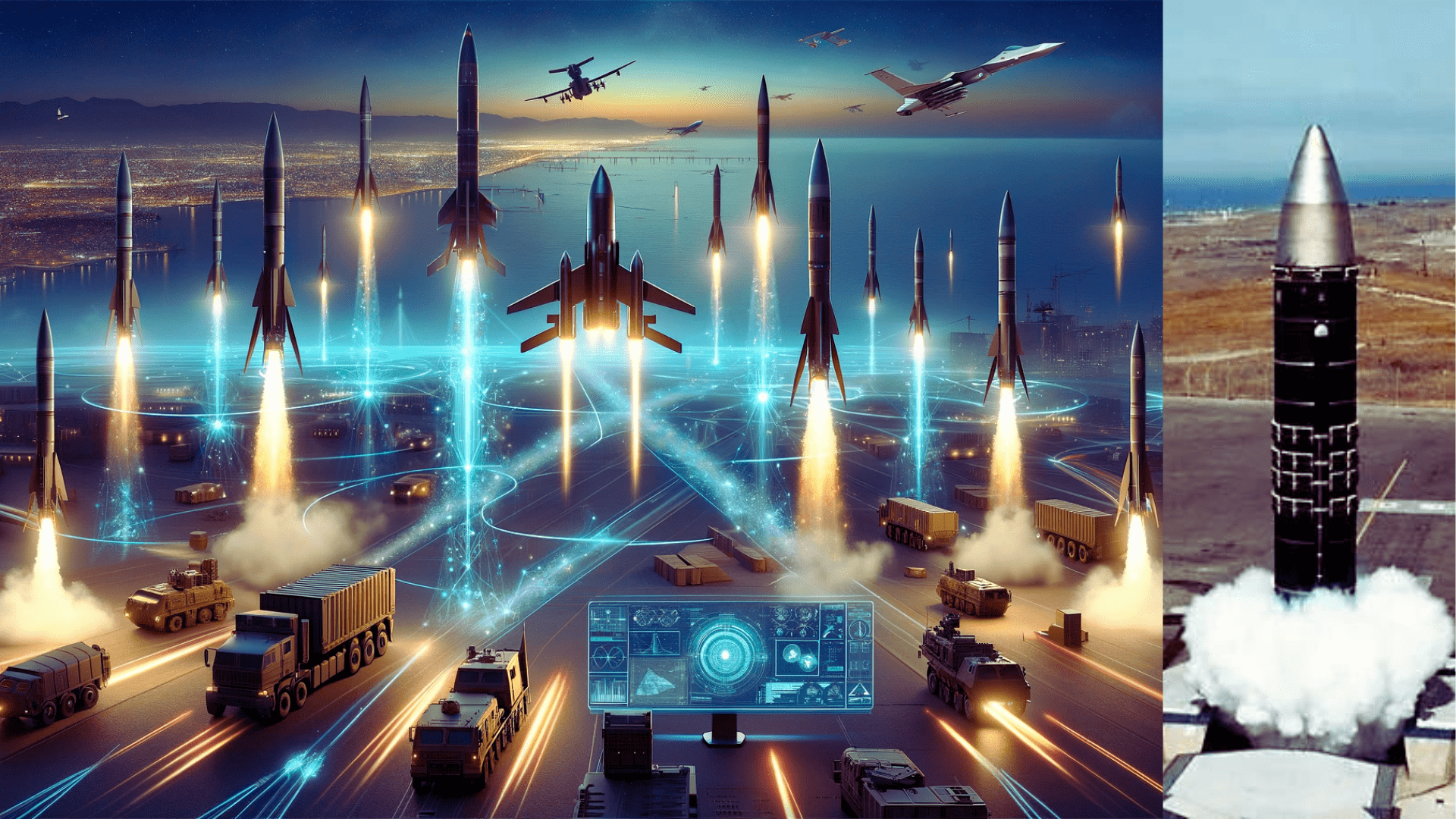A ballistic missile is a type of missile designed to deliver warheads to a target via a high, arching trajectory. Unlike cruise missiles, which are propelled throughout their flight and can navigate towards targets, ballistic missiles are only powered during the initial phase of their flight; the majority of their journey is governed by gravity and atmospheric dynamics. These missiles can carry a range of payloads including conventional explosives, nuclear weapons, and chemical, or biological munitions. They vary in range and size, classified typically into short-, medium-, and long-range systems, each capable of delivering a destructive payload over considerable distances with high accuracy.
The Evolution of Ballistic Missiles
Key Developments in Missile Technology
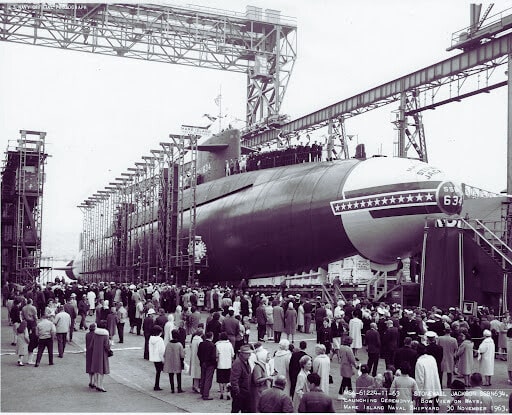
The evolution of ballistic missile technology has been marked by several key developments:
- Early Development: The concept of ballistic missiles dates back to World War II with the German V-2 rocket, which was the world’s first long-range guided ballistic missile.
- ICBMs and the Cold War: The development of intercontinental ballistic missiles (ICBMs) during the Cold War significantly advanced missile technology. These missiles were capable of delivering nuclear warheads across continents, drastically changing the strategic military landscape.
- MIRV Technology: Multiple independently targetable reentry vehicles (MIRVs) were developed to allow a single missile to carry multiple warheads, each capable of striking different targets. This innovation multiplied the lethality of single launches.
- Advancements in Guidance Systems: Improvements in guidance systems have dramatically increased the accuracy of ballistic missiles. Early ballistic missiles had relatively primitive guidance systems, but modern missiles use advanced navigation technologies like GPS and inertial guidance to hit targets with pinpoint accuracy.
- Anti-Ballistic Missile Systems: In response to ballistic missile threats, anti-ballistic missile (ABM) systems have been developed. These systems are designed to intercept and destroy incoming missiles before they reach their targets, adding a new layer to defense strategies.
- Recent Innovations: Recent advancements include the development of hypersonic glide vehicles, which can travel at speeds multiple times the speed of sound, complicating interception efforts.
These developments have not only advanced military capabilities but have also raised significant global security and arms control issues, prompting ongoing international discussions on missile defense and disarmament.
The Role of Ballistic Missiles in Modern Warfare
Ballistic missiles play a crucial role in modern warfare, characterized by their strategic and tactical applications:
- Strategic Deterrence: Ballistic missiles, particularly those capable of carrying nuclear warheads, serve as key tools for strategic deterrence. Nations use the threat of massive, retaliatory strikes to deter adversaries from attacking. Intercontinental ballistic missiles (ICBMs) are central to this strategy, capable of delivering warheads across global distances.
- Tactical Use: Shorter-range ballistic missiles provide military forces the capability to strike targets quickly and with considerable firepower over shorter distances. These missiles are used to destroy strategic enemy assets like command centers, and missile sites, and gather troops, altering the tactical landscape swiftly.
- Anti-Ballistic Missile Systems: The development and deployment of anti-ballistic missile (ABM) systems are directly tied to the threat posed by ballistic missiles. These systems are designed to intercept and neutralize incoming missiles, adding a layer of defense and complicating enemy attack plans.
- Political Influence: The possession and potential use of ballistic missiles also carry significant political weight, influencing international relations and power dynamics. Countries with advanced missile capabilities often use them as tools for regional influence and as bargaining chips in international negotiations.
- Modernization and Advancements: Ongoing advancements in missile technology, such as improvements in guidance systems, mobility, and stealth capabilities, continue to enhance their effectiveness and reliability in warfare scenarios.
In summary, ballistic missiles significantly impact modern military strategies and international security dynamics, serving both as weapons of war and instruments of peace through deterrence.
Understanding the Mechanics of Ballistic Missiles
The Components of a Ballistic Missile
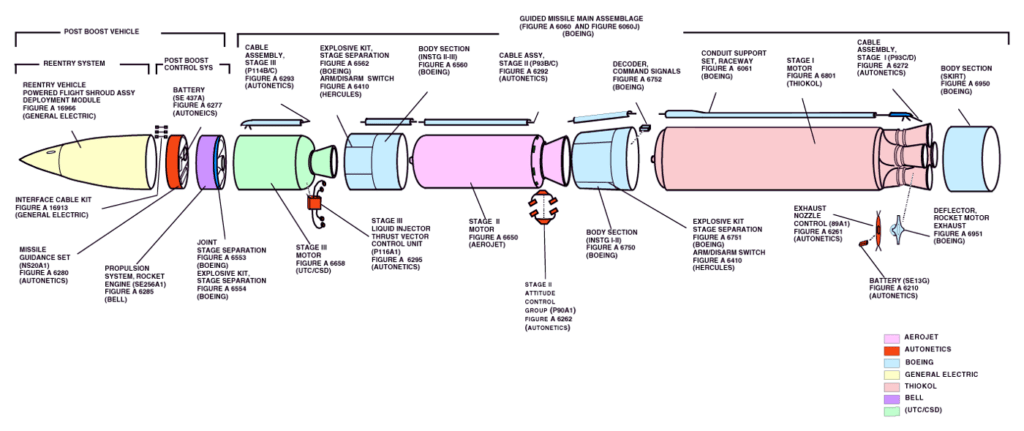
Ballistic missiles are sophisticated delivery systems designed to transport payloads, such as conventional or nuclear warheads, from one point to another through an arced trajectory. The basic components of a ballistic missile include:
- Airframe: This is the structural body of the missile, typically made from lightweight, strong materials. It houses all other components and provides the structural integrity required to withstand the stresses of launch and flight.
- Propulsion System: Ballistic missiles use rocket engines for propulsion. These can be solid-fuel or liquid-fuel rockets. The propulsion system is responsible for providing the necessary thrust to escape the Earth’s atmosphere and to place the missile on its trajectory towards the target.
- Guidance System: This critical component includes onboard computers, navigation systems, and control mechanisms that direct the missile’s path after launch. Improvements in guidance systems have significantly enhanced the accuracy and maneuverability of modern missiles.
- Warhead: The payload carried by the missile, which can be conventional (explosives, chemicals) or nuclear. The type and size of the warhead depend on the missile’s intended use and target.
- Re-entry Vehicle: In the case of intercontinental ballistic missiles (ICBMs), the re-entry vehicle houses the warhead and must withstand high temperatures and mechanical stresses of re-entering the Earth’s atmosphere.
Understanding these components is crucial for comprehending how ballistic missiles function and the potential impact they can have in military scenarios.
How Ballistic Missiles Are Launched
Ballistic missiles are launched using a sequence that begins with the preparation of the missile, followed by ignition of the propulsion system, and culminating in the missile’s ascent along a predetermined trajectory:
- Preparation: The missile is typically housed in a silo, on a mobile launcher, or aboard a submarine or ship. Before launch, all systems are checked, and the missile is fueled if necessary, although many modern missiles use solid propellants that are pre-loaded.
- Ignition: The launch sequence is initiated, igniting the missile’s engines. For liquid-fueled missiles, this involves pumping the fuel and oxidizer into the combustion chamber where they ignite. For solid-fuel missiles, the propellant ignites with an igniter.
- Lift-Off: Once the engines are ignited, the missile lifts off from its platform. This phase involves overcoming gravitational forces and requires significant thrust.
- Powered Flight: During the initial part of its flight, the missile is powered by its engines. This phase lasts until the fuel is exhausted. The missile follows a predetermined path controlled by its onboard guidance system, which adjusts the flight path to correct any deviations.
- Ballistic Trajectory: After engine burnout, the missile enters a ballistic trajectory, coasting in an arc under the influence of gravity. The path depends on the angle of launch, initial speed, and the Earth’s rotation.
- Re-entry and Impact: For longer-range missiles, the warhead detaches and re-enters the Earth’s atmosphere, descending towards the target. The re-entry phase involves high temperatures and stresses on the warhead.
This general sequence allows ballistic missiles to deliver payloads over vast distances with varying degrees of accuracy, depending on their guidance and propulsion technologies.
Types of Ballistic Missiles
Short-Range Ballistic Missiles (SRBMs)
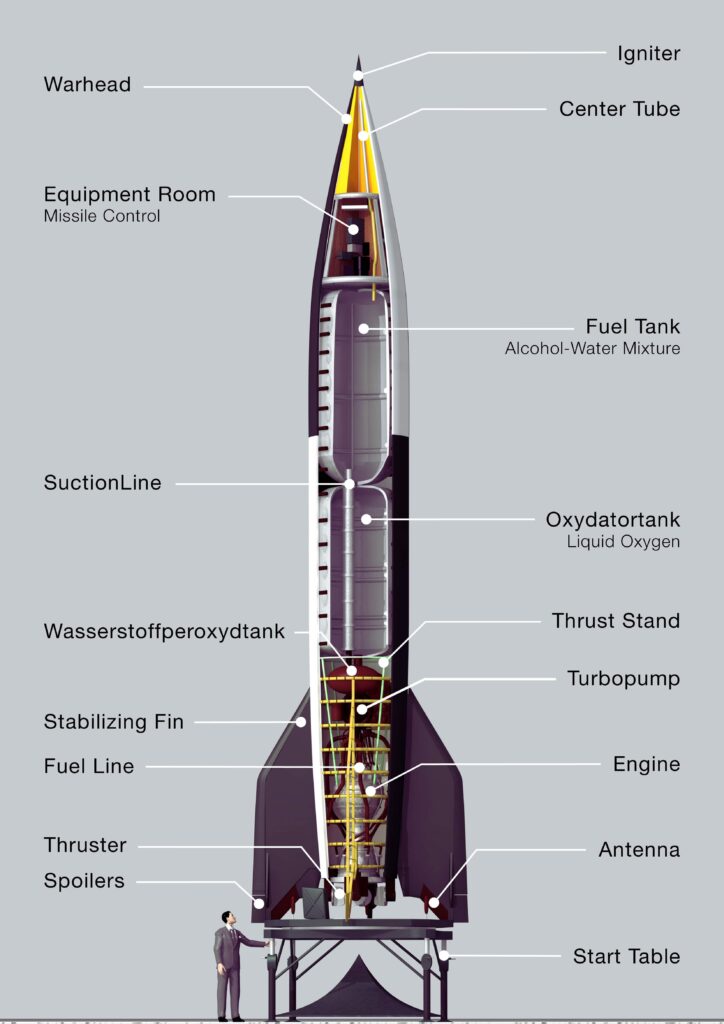
Short-Range Ballistic Missiles (SRBMs) are a category of ballistic missiles designed to cover distances from about 1,000 kilometers up to 3,000 kilometers. Here are some key points about SRBMs:
- Definition and Range: SRBMs are defined by their relatively short range, suitable for targeting within a specific region. These missiles are capable of striking targets up to about 3,000 kilometers away, making them suitable for tactical military operations.
- Design and Operation: Like all ballistic missiles, SRBMs follow a parabolic trajectory and are launched vertically. Their design generally includes a rocket motor and a payload, which is often a conventional or nuclear warhead.
- Guidance and Accuracy: SRBMs use inertial or satellite navigation systems to guide their flight to the target. The accuracy of SRBMs has improved significantly with advancements in guidance technology, allowing for more precise targeting.
- Usage: Due to their range and payload capabilities, SRBMs are often used by military forces for hitting strategic targets within neighboring countries or regions. They are a common feature in the arsenals of several countries seeking to enhance their regional deterrence capabilities.
- Examples: Notable examples of SRBMs include the Soviet/Russian Scud missile and the American MGM-140 ATACMS.
SRBMs play a significant role in modern military strategy, especially in regions where countries are nearby and conflict potentials are high.
Medium-Range Ballistic Missiles (MRBMs)
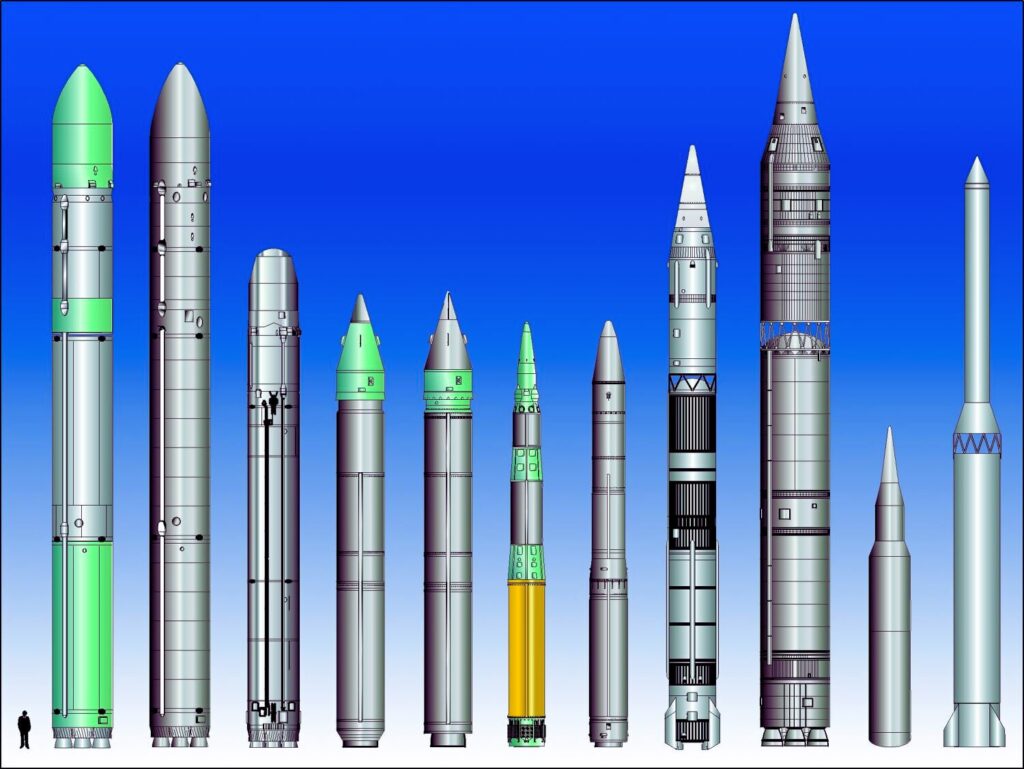
Medium-Range Ballistic Missiles (MRBMs) are missiles with a range longer than Short-Range Ballistic Missiles (SRBMs) but shorter than Intercontinental Ballistic Missiles (ICBMs). Specifically, MRBMs have the following characteristics:
- Range: MRBMs typically cover distances between 1,000 and 3,000 kilometers (620 to 1,860 miles).
- Purpose: These missiles are primarily used for strategic targets within a medium geographical range, balancing the capabilities of SRBMs and longer-range options.
- Deployment: They can be deployed in various configurations, including mobile launch platforms, making them versatile and harder to detect before launch.
- Guidance Systems: MRBMs typically use advanced guidance systems, including inertial navigation supplemented by satellite guidance to improve accuracy.
MRBMs are considered a crucial component of many countries’ military strategies, providing a significant deterrence and strike capability at regional levels.
Intercontinental Ballistic Missiles (ICBMs)
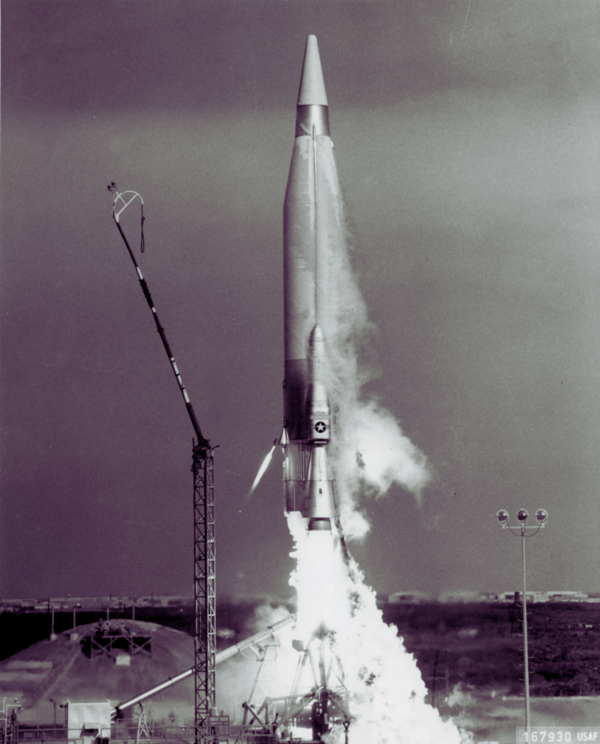
Intercontinental Ballistic Missiles (ICBMs) are long-range ballistic missiles with a minimum range typically considered to be over 5,500 kilometers (about 3,400 miles), designed primarily for nuclear weapons delivery (delivering one or more thermonuclear warheads). Unlike shorter-range ballistic missiles, ICBMs can achieve suborbital spaceflight before re-entering the atmosphere to reach their predetermined targets. This capability allows them to be launched from a controlled location, traversing through space, and hitting targets across the globe, which makes them a critical component of the strategic nuclear forces of several nations.
Navigating the Flight Path
The Role of Inertial Guidance Systems
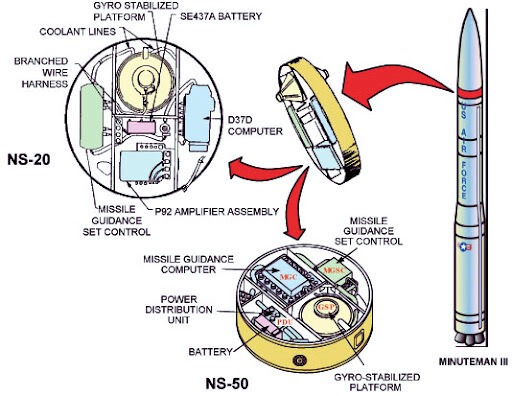
Inertial guidance systems are crucial for navigating the flight paths of ballistic missiles. These systems use a combination of accelerometers and gyroscopes to measure the acceleration and orientation of the missile, independent of any external references. This allows the missile to maintain an accurate trajectory from launch to target without the need for external signals that could be jammed or interfered with.
Here’s how it works:
- Initialization: Before launch, the inertial guidance system is programmed with the desired flight path and target coordinates.
- Launch: Upon launch, the system begins to measure and integrate the acceleration data to track velocity and displacement over time.
- Mid-course Corrections: The system continuously checks its calculated position against the planned trajectory and makes adjustments to ensure the missile remains on course.
- Terminal Phase: As the missile nears its target, the inertial guidance may work in conjunction with other targeting systems (like terminal guidance systems) to fine-tune the approach and impact precision.
This type of guidance system is advantageous in high-speed, long-range scenarios typical of ballistic missile operations because it is immune to jamming and does not emit signals that can be detected by enemy radar.
Advances in GPS and Other Technologies
Advancements in GPS and other technologies have significantly enhanced the capabilities of ballistic missile systems. Here are key advancements:
- Enhanced GPS Accuracy: Modern GPS technology provides more accurate and reliable location data. This has improved the targeting precision of ballistic missiles, allowing them to hit targets with minimal deviation from their intended point of impact.
- Integration of Sensors and AI: The integration of advanced sensors and artificial intelligence (AI) in missile systems allows for real-time data processing and decision-making during flight. This results in improved navigation, obstacle avoidance, and adaptation to changing conditions.
- Anti-Jamming Technologies: With the rise of electronic warfare, anti-jamming technologies have become crucial. These systems protect the GPS signals from being disrupted or spoofed, ensuring that the missile remains on its planned trajectory even in contested environments.
- Advanced Propulsion Systems: Developments in propulsion technology have extended the range and speed of ballistic missiles, making them harder to detect and intercept.
- Networked Communication: Advances in secure, real-time communication technologies allow missiles to receive updates and recalibrations during flight, adapting to dynamic battlefield conditions or changes in target prioritization.
These technological enhancements not only increase the effectiveness of ballistic missiles but also raise strategic considerations for defense systems worldwide.
Ballistic Missiles and International Security
Treaty Agreements and Regulations

Treaty agreements and international regulations on ballistic missiles are crucial for maintaining global security and preventing the proliferation of missile technology. Here are some key agreements:
- Missile Technology Control Regime (MTCR): Established in 1987, the MTCR is a voluntary partnership between 35 countries. It aims to prevent the proliferation of missile and unmanned aerial vehicle technology capable of carrying a 500 kg payload for at least 300 km.
- Intermediate-Range Nuclear Forces Treaty (INF Treaty): Signed in 1987 between the USA and the USSR (now Russia), this treaty eliminated all nuclear and conventional missiles, as well as their launchers, with ranges of 500–1,000 km (short-range) and 1,000–5,500 km (intermediate-range). Though the USA withdrew from this treaty in 2019, citing violations by Russia, it was a pivotal agreement in missile control.
- Strategic Arms Reduction Treaty (START): A series of arms reduction treaties between the United States and the Soviet Union/Russian Federation, START treaties (including New START) focus on limiting the numbers of strategic weapons and associated delivery systems.
- Hague Code of Conduct against Ballistic Missile Proliferation (HCOC): Initiated in 2002, HCOC is not a treaty but a voluntary measure that has about 140 signatories. The Code aims to prevent and curb the proliferation of ballistic missile systems capable of delivering weapons of mass destruction.
These treaties and agreements form a framework that nations use to regulate and control the spread and improvement of ballistic missile technologies, thereby contributing to international peace and stability.
The Threat of Ballistic Missiles to Global Peace
Ballistic missiles represent a significant threat to global peace due to their ability to deliver weapons of mass destruction (WMDs) over long distances. Several aspects heighten this threat:
- Proliferation: The spread of missile technology to volatile regions can destabilize local and global security dynamics. Initiatives like the Missile Technology Control Regime (MTCR) aim to prevent such proliferation by establishing guidelines that limit the transfer of missile technology capable of carrying substantial payloads over considerable distances.
- Capabilities: Ballistic missiles are capable of delivering nuclear, chemical, or biological warheads. This capability makes them a potent tool for state-sponsored aggression and a desirable asset for rogue states and non-state actors aiming to amplify their geopolitical influence and military reach.
- Deterrence and Defense: The development and deployment of ballistic missiles by nations can lead to an arms race, prompting neighboring countries to enhance their missile defense systems, thus escalating military tensions rather than fostering stability.
- International Regulations and Treaties: Treaties like the New START or the Hague Code of Conduct against Ballistic Missile Proliferation (HCOC) are crucial in managing the risks associated with ballistic missiles. These agreements facilitate transparency, encourage restraint, and aim to curb the spread of technologies essential for missile development.
The international community continues to face challenges in enforcing these treaties and ensuring compliance, particularly as technological advances make missile systems more accessible and harder to detect and intercept.
The Future of Ballistic Missile Technology
Emerging Technologies in Missile Defense

Emerging technologies in missile defense are rapidly transforming how nations protect against the threat of ballistic missiles. These advancements are particularly crucial as missile technology itself becomes more sophisticated. Here are some key technologies shaping the future of ballistic missile defense:
- Laser Weapons Systems: These systems use directed energy to destroy or disable missiles in flight. Their development is prioritized due to their potential for high precision and low cost per shot.
- Hypersonic Defense Technologies: As adversaries develop faster, more maneuverable hypersonic missiles, defense systems are also advancing to intercept these threats. This includes radar and sensor technologies that can detect hypersonic trajectories early.
- Artificial Intelligence (AI) and Machine Learning (ML): AI and ML are being integrated into missile defense systems to improve threat detection, decision-making speeds, and response accuracy. AI helps analyze vast amounts of data for quicker threat assessment and response.
- Advanced Radar and Sensor Technologies: Enhanced radar systems provide earlier detection and more accurate tracking of incoming missiles, essential for intercepting them at greater distances.
- Space-based Sensors: Placing sensors in space can provide global coverage, persistent surveillance, and early tracking of missiles right from launch.
- Network-Centric Warfare: This involves the integration of various sensor and weapon systems across platforms and domains, allowing for a coordinated and quicker defense response against missile threats.
These technologies not only aim to enhance the effectiveness of missile defenses but also serve as deterrents to potential aggressors, ensuring advancements in missile technology do not undermine international security.
Challenges in Missile Technology Innovations
The development of missile technology faces several significant challenges that can impact the strategic balance and defense capabilities globally:
- Complexity in Countering Hypersonic Missiles: As missile speeds increase with hypersonic technology, the difficulty in detecting, tracking, and intercepting these weapons grows. Systems must evolve to address these ultra-fast and maneuverable threats.
- Integration of New Technologies: Incorporating advanced technologies such as artificial intelligence, space-based sensors, and laser defense systems requires seamless integration with existing systems. This integration must be flawless to maintain the effectiveness of missile defenses.
- Rapid Advancements of Adversaries: Potential adversaries are quickly improving their missile capabilities, which necessitates continuous updates and adaptations of missile defense strategies to stay ahead of these threats.
- Cost and Resource Allocation: The high costs associated with developing, testing, and deploying advanced missile defense systems pose financial and resource allocation challenges. Balancing these costs while ensuring effective defense coverage remains a critical issue.
- Policy and Strategic Implications: Each innovation in missile technology not only affects technical and operational aspects but also has strategic implications. Reviews and updates of defense policies must reflect the evolving capabilities and threat landscapes.
These challenges highlight the dynamic and intricate nature of developing future missile technologies. Overcoming them requires coordinated efforts in technology development, strategic planning, and international cooperation.
Conclusion
The evolution of ballistic missile technology and its defense mechanisms remains a pivotal aspect of global security and military strategy. Over the years, the increasing sophistication of missile technology has escalated the challenges associated with countering missile threats. Developments in hypersonic missiles and advancements in nuclear capabilities have significantly complicated the defense landscape. The integration of cutting-edge technologies, such as AI and space-based systems, into missile defense architectures is imperative to keep pace with these advancements.
Moreover, the geopolitical implications of missile proliferation and the strategic balancing act among nations highlight the enduring relevance of ballistic missiles in international relations. As nations continue to enhance their missile capabilities, the complexity of developing effective missile defenses also grows. This ongoing arms race underscores the critical need for continued innovation in missile technology and robust international treaties aimed at controlling and mitigating the risks associated with missile proliferation.
In summary, the future of ballistic missiles and their defense remains a complex, dynamic field that is crucial for national security and international stability.
Read also: What is a Lag Putt?
